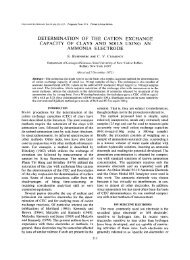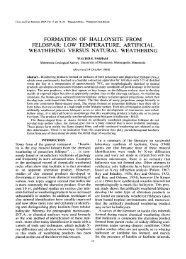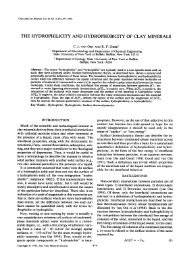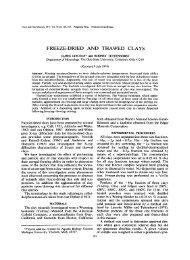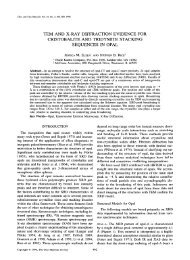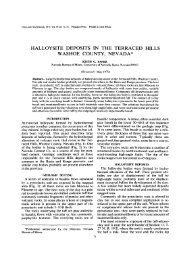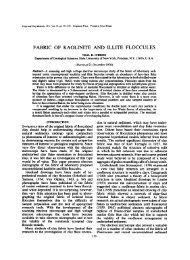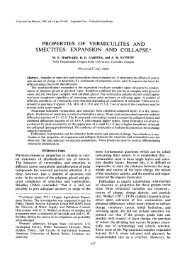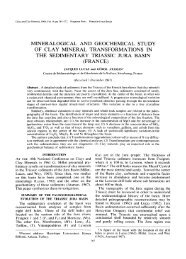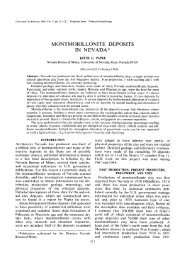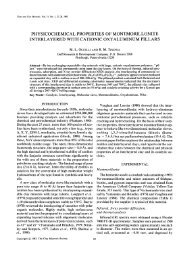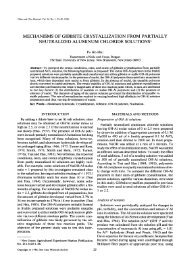THE INTERLAYER STRUCTURE OF La-VERMICULITE
THE INTERLAYER STRUCTURE OF La-VERMICULITE
THE INTERLAYER STRUCTURE OF La-VERMICULITE
You also want an ePaper? Increase the reach of your titles
YUMPU automatically turns print PDFs into web optimized ePapers that Google loves.
Clays and Clay Minerals, Vol. 46, No. 6, 629-635, 1998.<br />
<strong>THE</strong> <strong>INTERLAYER</strong> <strong>STRUCTURE</strong> <strong>OF</strong> <strong>La</strong>-<strong>VERMICULITE</strong><br />
PHILLIP G. SLAt)E, ~ PETER G. SELF 2 AND JAMES P. QUIRK 3<br />
1 CSIRO <strong>La</strong>nd and Water, Glen Osmond, South Australia 5064<br />
2 Ian Wark Research Institute, University of South Australia, The Levels, South Australia 5095<br />
3 Department of Soil Science and Plant Nutrition, University of Western Australia, Nedlands, Western Australia 6009<br />
Abstract--The structure of the interlayer cation-water system in <strong>La</strong>-vermiculite with a unit cell of a =<br />
5.33(5), b = 9.18(6), c = 15.13(9) A and [3 = 96.82(7) ~ has been determined in space group C2/m. Under<br />
ambient conditions, the interlayer <strong>La</strong> cations are distributed on a 3a b superlattice which disappears<br />
on dehydration but returns on rehydration. The basal spacing does not change during the dehydration/<br />
rehydration process. The character of the superlattice spots indicate that the cation-water system, at<br />
ambient conditions, is ordered over relatively large domains. The <strong>La</strong> cations are surrounded by 8 neigh-<br />
boring water molecules in a distorted cubic arrangement. The spaces between the <strong>La</strong>-water clusters are<br />
occupied by triads of water molecules that are relatively mobile.<br />
Key Words--8-Coordinated <strong>La</strong>, <strong>La</strong>-vermiculite, Ordered, Structure.<br />
INTRODUCTION<br />
Detailed descriptions of water-cation networks be-<br />
tween the silicate layers in the frequently fine-grained<br />
and imperfectly crystalline expansive layer silicates<br />
are difficult to obtain by crystallographic methods.<br />
Even vermiculites, which are available as large, rela-<br />
tively well-crystallized flakes, exhibit layer stacking<br />
disorder that causes their diffraction patterns to show<br />
streaks parallel to Z* for Okl reflections where k ~ 3n.<br />
Such stacking disorder, involving semi-random layer<br />
displacements of +-b/3, is always found in Mg-ver-<br />
miculite. There it seems to be part of a mechanism<br />
enabling layer charges, resulting from disordered sub-<br />
stimtions in tetrahedral sites (Shirozu and Bailey<br />
1966), to be balanced by interlayer cations adjacent to<br />
those sites (Slade et al. 1985).<br />
However, for the 2-layer hydrates developed by Na-<br />
and Ca-vermiculites at humidities with P/Po > 0.5,<br />
sharp diffraction patterns indicative of a high degree<br />
of stacking order can be obtained. It has been shown<br />
by de la Calle (1977) and Slade et al. (1985) that, in<br />
the ordered structures of these vermiculites, the ditri-<br />
gonal cavities in adjacent silicate layers face each oth-<br />
er across the interlayers as they commonly do in mi-<br />
cas.<br />
This relative disposition of adjacent silicate layers<br />
contrasts with that found in natural semi-ordered Mg-<br />
vermiculite (Mathieson and Walker 1954; Shirozu and<br />
Bailey 1966; Alcover and Gatineau 1980), where the<br />
tetrahedral bases in any given silicate layer can be op-<br />
posite to the ditrigonal cavities in the adjacent silicate<br />
layer This arrangement of adjacent silicate layers<br />
leads to a structure in which the interlayer Mg ions<br />
can occur between the bases of aluminous tetrahedra.<br />
In the 2-layer hydrates of Na- and Ca-vermiculites,<br />
however, Na and Ca ions have a high probability of<br />
occurring between the bases of silicon tetrahedra but<br />
Copyright 9 1998, The Clay Minerals Society 629<br />
Ca ions also occur between ditrigonal cavities (Slade<br />
et al. 1985).<br />
The positions and properties of the interlayer cations<br />
and the structure of the adjacent silicate layers influ-<br />
ence the organization of the interlayer water molecules<br />
which generally have an ordered arrangement, al-<br />
though they are somewhat mobile. The positions of<br />
water molecules associated with exchangeable cations<br />
with high hydration energies should be the most read-<br />
ily characterized because such cations can be expected<br />
to "lock" the positions of the water molecules. The<br />
results of a study by Slade and Quirk (1991) indicate<br />
that <strong>La</strong> 3+ would be such a cation.<br />
The exchange reactions between trivalent lanthanide<br />
ions and clay minerals have been examined in studies<br />
of the uptake of radioactive wastes (Miller et al. 1982)<br />
and of the distribution of rare earths in soil clays (Bo-<br />
not-Courtois and Jaffrezic-Renault 1982). Work by<br />
Bruque et al. (1980), <strong>La</strong>ufer et al. (1984) and Olivera-<br />
Pastor et al. (1988) showed that lanthanide ions can<br />
be taken up in excess of a clay's exchange capacity.<br />
This effect was reported to be pH-dependent, with the<br />
excess increasing with increasing pH.<br />
Slade and Quirk (1991) reported that the interlayer<br />
expansion that occurs when smectites take up <strong>La</strong> 3+<br />
ions from <strong>La</strong>C13 solutions is less than if solutions of<br />
chlorides of lower-charged ions such as Mg 2+, Ca ~+ or<br />
Na + were used. The intense electrostatic field about<br />
interlayer trivalent <strong>La</strong> ions produces relatively strong<br />
attractive forces between the hydrated <strong>La</strong> ions and the<br />
adjacent silicate layers; such forces not only restrict<br />
swelling, but also contribute to the structural order.<br />
The present study of <strong>La</strong>-exchanged vermiculite has<br />
taken advantage of its high degree of stacking order<br />
and examined its interlayer structure at ambient con-<br />
ditions by X-ray methods.
630 Slade, Self and Quirk Clays and Clay Minerals<br />
Table 1. EDX analysis of Llano vermiculite after <strong>La</strong> ex-<br />
change. The data of Norrish (1973) for the original material<br />
is given for comparison.<br />
After <strong>La</strong> exchange Original material<br />
SiO2 39.96<br />
A1203 15.05<br />
Fe203 0.74<br />
MnO<br />
TiO2<br />
MgO 25.95<br />
K:O<br />
CaO<br />
NaO2<br />
<strong>La</strong>203 12.50<br />
Cations per 22<br />
oxygen equivalents<br />
Si 5.735 }<br />
A1TM 2.265 8.00<br />
A1 vl 0.251 ]<br />
Fe 3+ 0.077 / 5.89<br />
Mg 5.565<br />
Ti<br />
Mn<br />
<strong>La</strong> 3+ 0.650 l charge<br />
K<br />
Ca __ J 1.95<br />
45.56<br />
15.82<br />
1.40<br />
0.13<br />
0.38<br />
29.66<br />
0.17<br />
6.86<br />
Cations per 22<br />
oxygen equivalents<br />
5.79<br />
2.21<br />
J<br />
8.O0<br />
0.16<br />
0.13<br />
5.62 5.97<br />
0.04<br />
0.01<br />
-- } charge<br />
0.03 1.89<br />
0.93<br />
MATERIALS AND METHODS<br />
After being Na-saturated as described by Slade et<br />
al. (1985), the highly charged vermiculite from Carl<br />
Moss Ranch, Llano County, Texas, was used as the<br />
starting material for the current work. <strong>La</strong>-exchange<br />
was carried out by refluxing the Na-saturated flakes in<br />
0.5 M <strong>La</strong>C13 (pH = 4.5) at 50 ~ for 3 d; the solution<br />
was changed daily. The flakes were finally washed<br />
with warm distilled water until they were chloride free.<br />
Table 1 shows the results of analyzing the product with<br />
a Cambridge SEM fitted with an energy-dispersive X-<br />
ray (EDX) analysis system. The X-ray fluorescence<br />
(XRF) analysis and the structural formula obtained by<br />
Norrish (1973) for the original vermiculite are also<br />
given in Table 1. A comparison of the 2 sets of results<br />
shows that the composition of the silicate layers did<br />
not change significantly during treatment.<br />
Preliminary Study<br />
By using an evacuable 57.3-mm-diameter Gandolfi<br />
X-ray diffraction (XRD) camera, in the rotation mode,<br />
and with a <strong>La</strong>-vermiculite flake set either perpendic-<br />
ular (and stationary) to the X-ray beam or rotated<br />
about the axis perpendicular to the beam, the following<br />
were observed:<br />
1) Under ambient conditions, a well-developed set<br />
of superlattice reflections was present (Figure la).<br />
These indicated that the <strong>La</strong> ions are ordered within<br />
domains and occupy positions in a C face-centered<br />
supercell, having dimensions 3a b, where a and b<br />
are the dimensions of the standard vermiculite cell.<br />
2) Under a vacuum, -9 10 2 mbar, the superlat-<br />
tice reflections disappeared (Figure lb). The superlat-<br />
tice reflections were found to reappear when ambient<br />
conditions were restored.<br />
3) The basal spacing of the crystal was unaffected<br />
by the vacuum and remained at -15 A throughout the<br />
experiment.<br />
X-ray Weissenberg photographs, taken under am-<br />
bient conditions, were used to examine the Y'Z* lat-<br />
tice planes in the diffraction patterns of orientated<br />
flakes. The subcell Okl reflections, including those with<br />
k r 3n, were found to be discrete and so, for the sil-<br />
icate layers, a high degree of stacking order exists par-<br />
allel to the Y-axis. The superlattice reflections were<br />
streaked parallel to Z* and, hence, the ordering of the<br />
<strong>La</strong> ions is 2-dimensional with no coupling between<br />
adjacent interlayers. The distribution of the reflections<br />
showed the structure to have a repeat distance along<br />
the Z axis corresponding to a single silicate layer and<br />
with the ditrigonal cavities in adjacent layers opposite<br />
each other, as in Na- and Ca-vermiculite.<br />
Zero and non-zero layer Weissenberg photographs<br />
taken about the X and Y axes were used to determine<br />
the unit cell dimensions and probable space group for<br />
<strong>La</strong>-vermiculite. The dimensions obtained for the sub-<br />
cell are: a = 5.33(5), b = 9.18(6), c = 15.13(9) ,~,<br />
and [3 = 96.82(7) ~ In the absence of any direct evi-<br />
dence to the contrary, and without regarding the su-<br />
perlattice reflections, the space group usually associ-<br />
ated with 1M mica polytypes (C2/m) was used in cal-<br />
culations to establish the structure.<br />
Data Collection and Determination of Silicate<br />
<strong>La</strong>yer Structure<br />
Single-crystal diffraction data were collected on a<br />
SUPPER 2-circle X-ray diffractometer, whose method<br />
of use for data collection on intercalated vermiculites<br />
has been discussed by Slade and Stone (1983) and also<br />
by Slade et al. (1987). For the present work, the con-<br />
trol algorithm was rewritten to operate on a Toshiba<br />
laptop T1200 PC. Accumulated counts were displayed<br />
for each 0.05 ~ step along scans through reflections so<br />
that their profiles could be monitored during measure-<br />
ments. An to/20 step scan and filtered MoK~ radiation<br />
were used. The <strong>La</strong>-vermiculite crystal employed for<br />
data collection had the dimensions 405 596 28<br />
p,m. Data from 7 reciprocal lattice layers perpendicular<br />
to the X rotation axis were measured and the index<br />
ranges were 0 -< h -< 6, -12
Vol. 46, No. 6, 1998 <strong>La</strong>-vermiculite structure 631<br />
Figure 1. XRD photographs of a <strong>La</strong>-vermiculite crystal with basal cleavage perpendicular to the X-ray beam. a) Ambient<br />
conditions; b) under vacuum. Camera cylindrical, d = 57.3 mm. Radiation CoKc~.<br />
tions were averaged and duplicate reflections were also<br />
merged. To phase the structure amplitudes, a trial mod-<br />
el incorporating only the atoms in the silicate layers<br />
was set up in the program ORFLS (Busing et al.<br />
1962). This program was also used for all least-squares<br />
structural refinements. The scaling factors for the re-<br />
ciprocal lattice layers were adjusted first, followed by<br />
the positional parameters and then the isotropic tem-<br />
perature factors. As the intensities of relatively few<br />
unique superlattice reflections were measurable, and<br />
then only in the X'Y* plane, they were not included<br />
in the data set. The structure amplitudes were each<br />
weighted according to the scheme of Cruickshank et<br />
al. (1961). After adjusting the atom parameters for the<br />
silicate layer atoms only, the R factor on the set of<br />
1108 unique reflections (omitting zeros) was 21%.<br />
RESULTS<br />
Following the least-squares adjustments, a series of<br />
3-dimensional Fourier electron density maps based<br />
upon Fob s and Fobs-Fcatc were computed.<br />
Since superlattice reflections could not be included<br />
in the calculations, the Fourier maps necessarily<br />
showed the C face-centering associated with the sub-<br />
cells. However, the true interlayer structure is based<br />
upon a C face-centered supercell, whose origin, within<br />
a given domain, may be at 0, 0, 89 or 89 89 89 with<br />
reference to the subcell. The computed Fourier maps<br />
for the subcell therefore necessarily represent an av-<br />
erage of the contents of subcells within different do-<br />
mains comprising the whole crystal.<br />
The section at z/c = 0.5 showed a strong peak at 0,<br />
0, 89 and also at the related position 89 89 89 while
632 Slade, Self and Quirk<br />
Figure 2. Section through a 3-dimensional (Fo-Fc) synthesis<br />
at zJc = 0.41. Contour interval regular but uncalibrated.<br />
the sections at z/c = 0.41, 0.39 and 0.34 showed well-<br />
developed peaks of approximately equal height, but<br />
only about a sixth of the height of the peak at 0, 0, lk.<br />
At this stage, the computer program DLS-76 for the<br />
simulation of crystal structures by geometric refine-<br />
ment (Baerlocher et al. 1977) was used to generate the<br />
possible coordinates for a set of water molecules about<br />
<strong>La</strong> at (0, 0, 89 or (89 89 89 The <strong>La</strong>-H20 distance was<br />
specified as 2.52 A in order to conform with the result<br />
obtained with X-ray absorption fine structure (EX-<br />
AFS) spectroscopy by Jones et al. (1991). The dis-<br />
tances between the water molecules and the nearest<br />
related surface oxygens were constrained at 2.84 A to<br />
accord with the results published by Mathieson and<br />
Walker (1954).<br />
After 10 cycles of least-squares adjustment, DLS-<br />
76 generated a set of positional coordinates for 8 water<br />
molecules. These coordinates accorded well with those<br />
of the 8 closest neighboring peaks about the <strong>La</strong> peaks<br />
Table 2.<br />
lite.<br />
Clays and Clay Minerals<br />
Positional and thermal parameters for <strong>La</strong>-vermicu-<br />
a/a y/b z/c B (~2)<br />
M(1) 0.000 0.500 0.000 0.49<br />
M(2) 0.000 0.167 0.000 0.38<br />
O(1) 0.358(1) 0.167 0.0716(5) 0.64<br />
OH(l) 0.859(1) 0.000 0.0698(5) 0.64<br />
T(1) 0.394(1) 0.167 0.1818(5) 0.67<br />
0(2) 0.143(2) 0.236(1) 0.2222(6) 1.39<br />
O(3) 0.438(2) 0.000 0.2209(6) 1.56<br />
<strong>La</strong> 0.500 0.500 0.500 11.25<br />
H20(1) 0.479(9) 0.500 0.336(7) 10.62<br />
H20(2) 0.000(9) 0.500 0.431 (7) 6.82<br />
H20(3) 0.265(9) 0.261(6) 0.435(7) 20.48<br />
H20(4) 0.167 0.500 0.396(7) 3.83<br />
H20(5) 0.579(9) 0.351 (6) 0.394(7) 5.46<br />
Key: Errors in parentheses are for last decimal place listed.<br />
H20(1), H20(2) and H20(3) are directly coordinated to <strong>La</strong>;<br />
H20(4 ) and H20(5 ) are uncoordinated.<br />
in the electron density maps. The positions of the re-<br />
maining peaks had triangular distributions on the sym-<br />
metry related planes of z/c = 0.41 and z = 0.59. These<br />
remaining peaks can be attributed to uncoordinated<br />
water molecules between the <strong>La</strong>/water polyhedra. Fig-<br />
ure 2 shows the electron density section at z/c = 0.4<br />
on which peaks associated with both the coordinated<br />
and the uncoordinated water molecules appear togeth-<br />
er.<br />
The coordinates for the crystallographically distinct<br />
water molecules, along with the coordinates for <strong>La</strong>,<br />
were then included in the structure model. Three fur-<br />
ther least-squares cycles were used to simultaneously<br />
adjust all of the atom parameters and the scale factors.<br />
These adjustments resulted in the thermal parameters<br />
for the water molecules becoming large but still pos-<br />
itive, the R factor on the non-zero reflections was<br />
17.5% for 50 variables. Table 2 gives the resulting<br />
positional and thermal parameters of both the silicate<br />
layer atoms and the interlayer atoms within a single<br />
ordered domain. In Table 2, the positional parameters<br />
for all atoms are referred to the standard unit cell.<br />
However, because of the superstructure, space group<br />
C2/m can only be applied to the interlayer atoms by<br />
referring them to the supercell that requires their x/a<br />
values given in Table 2 to be divided by 3. The bond<br />
lengths, calculated from positional coordinates for the<br />
interlayer atoms, are shown in Table 3, and Figure 3<br />
shows the structural relationship of a single sheet of<br />
water molecules to the interlayer cations and the ox-<br />
ygens in the adjacent silicate layer. Observed and cal-<br />
culated structure factors may be obtained from the au-<br />
thors upon request.<br />
DISCUSSION<br />
The 8 water molecules (H20(1), H20(2) and<br />
H20(3); Table 2) directly coordinated to the <strong>La</strong> cations<br />
are at the comers of distorted cubes that have one of
Vol. 46, No. 6, 1998 <strong>La</strong>-vermiculite structure 633<br />
Table 3. Bond lengths involving interlayer atoms in <strong>La</strong>-ver-<br />
miculite,<br />
Atoms Distances (A)<br />
<strong>La</strong>-H20(1) 2.5 (1)<br />
<strong>La</strong>-H20(2) 2.7 (1)<br />
<strong>La</strong>-H20(3) 2.7 (1)<br />
<strong>La</strong>-H20'(3) 2.7 (1)<br />
H20(1)-O(2) 3.0 (1)<br />
H20(1)-O(3) 3.2 (1)<br />
H20(4)-O(3) 2.8 (1)<br />
H20(5)-O(2) 2.8 (1)<br />
H20(4)-H20(5) 3.3 (1)<br />
H2(4)-H20'(4) 3.3 (1)<br />
H20(2)-H20(3) 4.5 (1)<br />
H20(3)-H20'(3) 4.4 (1)<br />
H20(2)-O(3) 3.2 (1)<br />
H20(3)-O(2) 3.2 (1)<br />
their body diagonals passing through the centers of<br />
water molecules (H20(1); Table 2) buried in opposite<br />
ditrigonal cavities. The <strong>La</strong> cations, including their hy-<br />
dration shells, are distributed through the interlayers<br />
on a face-centered lattice with dimensions -16 9 ,~<br />
(3a b). The intervals between the <strong>La</strong>/water poly-<br />
hedra are occupied by uncoordinated water molecules<br />
(H20(4) and HzO(5); Table 2) which are in ordered,<br />
trigonally arranged sites.<br />
From an extended EXAFS study of local environ-<br />
ments about lanthanide ions in vermiculites, Jones et<br />
al. (1991) found that the coordination numbers of in-<br />
terlayer lanthanide ions appeared to depend on wheth-<br />
er the lanthanide-exchanged vermiculite was examined<br />
in the form of a powder or as a film. Disparities were<br />
also noted between these results and the coordination<br />
numbers obtained for the corresponding lanthanides in<br />
solution as nitrates. For <strong>La</strong>, the EXAFS study showed<br />
coordination numbers of 6.1, 8.5 or 9, depending on<br />
whether the <strong>La</strong> was in a vermiculite powder, a ver-<br />
miculite-film or in solution. The coordination number<br />
of 8, obtained here from XRD, compares well with the<br />
value of 8.5 obtained by EXAFS on a vermiculite-film.<br />
Earlier X-ray studies of Ca-vermiculite by de la Cal-<br />
le (1977) and Slade et al. (1985) revealed that inter-<br />
layer Ca ions can be present in both 6- and 8-fold<br />
coordination. This contrasts with the result for <strong>La</strong> ions,<br />
which are present only in the larger 8-fold coordina-<br />
tion sites; the available, but smaller, 6-fold coordina-<br />
tion sites remain unfilled. The univalent radii of ions<br />
(Pauling 1960) can be used to calculate the radius ra-<br />
tios relative to oxygen as 0.67 for Ca 2+ and 0.79 for<br />
<strong>La</strong> 3+. These values show that the radius ratio for Ca 2+<br />
is slightly below, and for <strong>La</strong> > slightly above, the value<br />
of 0.732 at which the transition from cubic to octa-<br />
hedral coordination takes place. <strong>La</strong> is therefore more<br />
ideally surrounded by a cubic disposition of water<br />
molecules than is the case for Ca.<br />
The present study shows that the interlayer <strong>La</strong> ions<br />
occupy sites on centers between large triads of water<br />
molecules adjacent to the larger of the triangular<br />
groups of surface oxygens. To accommodate the <strong>La</strong><br />
ions, the normally larger triads of water molecules,<br />
which are hydrogen-bonded to the nearest surface ox-<br />
ygens, are further expanded so that H:O-H20 distances<br />
increase from -3.4 to -4.4 A. The data from Table 3<br />
show that this expansion is accompanied by an in-<br />
crease in the HzO-surface oxygen distances to 3.2 ,~,<br />
which exceeds the lengths of effective hydrogen<br />
Figure 3. Single lower sheet of water molecules in <strong>La</strong>-vermiculite. Water molecules are unshaded; adjacent surface oxygens<br />
are shaded gray; <strong>La</strong> cations are black. View perpendicular to the ab plane.
634 Slade, Self and Quirk Clays and Clay Minerals<br />
bonds. In addition, the cubic clusters of water mole-<br />
cules about the <strong>La</strong> ions necessitate that ditrigonal cav-<br />
ities in adjacent silicate layers should face each other<br />
across the interlayers and so produce a structure with<br />
only minimal stacking disorder.<br />
Except for those water molecules embedded in the<br />
ditrigonal cavities, only minor displacements of water<br />
molecules from positions in the usually distorted hex-<br />
agonal arrays are needed to create cubic environments<br />
about interlayer cation sites.<br />
The average <strong>La</strong>-water distance (2.65 --- 0.1 ,~) ob-<br />
tained in the present study is within the range of 2.52<br />
_+ 0.11 ,~ determined by Jones et al. (1991) from the<br />
EXAFS work. However, the X-ray results must be<br />
viewed in the context of there being considerable po-<br />
sitional disorder associated with the interlayer atomic<br />
positions. In particular, a Fourier section, at y/b = 89<br />
shows that the <strong>La</strong> peaks are spread out along a line<br />
parallel to the X axis. The large temperature factors<br />
associated with the water sites provide further evi-<br />
dence of the high degree of positional disorder that<br />
characterizes the structure of the water network. In the<br />
present study, the difficulties of specifying exact po-<br />
sitional coordinates for the water sites are further com-<br />
pounded by the low electron densities associated with<br />
them.<br />
Diffraction photographs showed that the basal spac-<br />
ing of <strong>La</strong>-vermiculite is the same under vacuum as<br />
under ambient conditions. Apparently the hydration<br />
energy of <strong>La</strong> is sufficiently high, 768 K cal g 1 ion<br />
(Bernal and Fowler 1933), to retain directly bonded<br />
water molecules. Hence, the size and shape of the cat-<br />
ion/water polyhedra remain constant. This situation<br />
contrasts with that for Na- and Ca-vermiculites which<br />
have basal spacings that vary with changes in relative<br />
humidity (the hydration energies of Na + and Ca 2+ are<br />
114 and 205 Kcal g-I ion, respectively). Under vacu-<br />
um, however, the uncoordinated interstitial water mol-<br />
ecules in <strong>La</strong>-vermiculite are removed and, as shown<br />
by the disappearance of the superlattice reflections, the<br />
spatial distribution of the polyhedra changes. These<br />
phenomena demonstrate that the interstitial water mol-<br />
ecules play a crucial role in producing the ordered dis-<br />
tribution of hydrated interlayer cations. Slade et al.<br />
(1989) showed that the well-ordered stacking of the<br />
silicate layers in 1,4-diazabicyclo[2,2,2]octane (DAB-<br />
CO)-intercalated vermiculite also displayed consider-<br />
able disorder when heated. This disorder was attribut-<br />
ed to the removal of water from between the organic<br />
cations. On rehydration, sharp diffraction patterns re-<br />
appeared and, hence, ordered cation/water structures<br />
were reestablished.<br />
The structural formula computed from the analytical<br />
results (Table 1) shows that if the effective charge for<br />
the <strong>La</strong> ions is assumed to be 3 then, within the limits<br />
of experimental error, the uptake of <strong>La</strong> by the Llano<br />
vermiculite used in this work does not exceed the<br />
amount needed to balance the layer charge. Under<br />
these conditions, a form of hydrolysis within the in-<br />
terlayers is still possible. The protons created in the<br />
process of reducing the charges on the <strong>La</strong>-water<br />
groups can also contribute to the neutralization of the<br />
layer charge.<br />
The superlattice reflections given by <strong>La</strong>-vermiculite<br />
are sharp and occur at reciprocal lattice points well<br />
out from the direct beam. This is consistent with the<br />
interlayer cations and water molecules being ordered<br />
within extensive domains. Alcover et al. (1973) re-<br />
ported that the diffraction pattern of Kenya vermiculite<br />
also included additional reflections, between the nor-<br />
mal Bragg reflections. The additional reflections, al-<br />
though more diffuse than those given by <strong>La</strong>-vermic-<br />
ulite, also showed that the interlayer Mg 2+ cations and<br />
water molecules in Kenya vermiculite are distributed<br />
on a centered 3a b lattice. The diffuseness of the<br />
extra reflections produced by Mg-vermiculite demon-<br />
strates that the ordered domains in its interlayers are<br />
smaller, and perhaps less highly ordered within them-<br />
selves, than are the ordered domains in <strong>La</strong>-vermiculite.<br />
The R factors obtained during the refinements of the<br />
<strong>La</strong>-vermiculite structure are higher than given for ex-<br />
ample by refinements of mica structures. Apparently,<br />
even if the stacking disorder of vermiculite is reduced,<br />
by specific interlayer species, other structural imper-<br />
fections remain. These degrade the overall diffraction<br />
patterns in ways that are not readily allowed for in<br />
structure refinements and so the derived structural pa-<br />
rameters are of relatively low accuracy. Despite these<br />
limitations, the present study demonstrates that valu-<br />
able structural information is obtainable from Fourier<br />
images.<br />
ACKNOWLEDGMENT<br />
The authors are grateful to S. McClure for his EDX anal-<br />
ysis of the <strong>La</strong>-vermiculite.<br />
REFERENCES<br />
Alcover JF, Gatineau L. 1980. Structure de l'espace interla-<br />
mellaire de la vermiculite Mg bicouche. Clay Miner 15:<br />
25 35.<br />
Alcover JE Gatineau L, Mdring J. 1973. Exchangeable cation<br />
distribution in nickel and magnesium vermiculite. Clays<br />
Clay Miner 21:131-136.<br />
Baerlocher Ch, Hepp A, Meier WM. 1977. DLS-76, a pro-<br />
gram for the simulation of crystal structures by geometric<br />
refinement. Institute of Crystallography and Petrography,<br />
Ziarich, Switzerland.<br />
Bernal JD, Fowler RH. 1933. A theory of water and ionic<br />
solution with particular reference to hydrogen and hydroxyl<br />
ions. J Chem Phys 1:515-548.<br />
Bonot-Courtois C, Jaft'rezic-Renault N. 1982. Etudes des<br />
6changes entre terres rares et cations interfoliaires de deux<br />
argiles. Clay Miner 17:409-420.<br />
Bruque D, Mozas T, Rodriguez A. 1980. Factors influencing<br />
retention of lanthanide ions by montmorillonite. Clay Min-<br />
er 15:413 420.
Vol. 46, No. 6, 1998 <strong>La</strong>-vermiculite structure 635<br />
Busing WR, Martin KO, Levy HA. 1962. ORFLS, a Fortran<br />
crystallographic least-squares refinement program. Oak<br />
Ridge Natl <strong>La</strong>b Tech Man 305. 75 p.<br />
de la Calle C. 1977. Structure des vermiculites, facteurs con-<br />
ditionnant les mouvements des feuillets [Ph.D. thesis]. Par-<br />
is: Univ Pet M Curie. CNRS No. A.O.11.024.<br />
Cruickshank DWJ, Pilling DW, Bujosa A, Lovell FM, Truter<br />
MR. 1961. Computing methods in the phase problem. Ox-<br />
ford: Pergamon Pr.<br />
Jones DJ, Rozi&e J, Olivera-Pastor R Rodriguiez-Castellon<br />
E, Jimbnez-L/3peza A. 1991. Local environment of inter-<br />
calated lanthanide ions in vermiculite. J Chem Soc, Faraday<br />
Trans 87(18):3077-3081.<br />
<strong>La</strong>ufer E Yarivc S, Steinberg M. 1984. The adsorption of<br />
quadrivalent cerium by kaolinite. Clay Miner 19:137 149.<br />
Mathieson AMcL, Walker GE 1954. Crystal structure of mag-<br />
nesium-vermiculite. Am Mineral 39:231-255.<br />
Miller SE, Heat GR, Gonz~ilez RE). 1982. Effects of temper-<br />
ature on the sorption of lanthanides by montmorillonite.<br />
Clays Clay Miner 30:111-122.<br />
Norrish K. 1973. Factors in the weathering of mica to ver-<br />
miculite. In: Serratosa JM, editors. Proc Int Clay Conf;<br />
1972; Madrid, Spain. Division de Ciencias, CSIC. p 417-<br />
432.<br />
Olivera-Pastor R Rodrfguez-Castilldn E, Rodrfguez Garcfa A.<br />
1988. Uptake of lanthanides by vermiculite. Clays Clay<br />
Miner 36:68-72.<br />
Panling L. 1960. The nature of the chemical bond. New York:<br />
Cornell Univ Pr. p 511-540.<br />
Shirozu J, Bailey SN. 1966. Crystal structure of a two layer<br />
Mg-vermiculite. Am Mineral 52:1124.<br />
Slade PG, Dean C, Schultz PK, Self PG. 1987 Crystal struc-<br />
ture of a vermiculite-anilinium intercalate. Clays Clay Min-<br />
er 35:177-188.<br />
Slade PG, Schultz PK, Tiekink ERT. 1989. Structure of a 1,<br />
4-diazabicyclo [2,2,2] octane-vermiculite intercalate. Clays<br />
Clay Miner 37:81-88.<br />
Slade PG, Stone PA. 1983. Structure of a vermiculite-aniline<br />
intercalate. Clays Clay Miner 31:200-206.<br />
Slade PG, Stone PA, Radoslovich EW. 1985. Interlayer struc-<br />
tures of the two-layer hydrates of Na- and Ca-vermiculites.<br />
Clays Clay Miner 33:51-61.<br />
Slade PG, Quirk JR 1991. The limited crystalline swelling of<br />
smectites in CaC12, MgC12, and <strong>La</strong>C13 solutions. J Colloid<br />
Interface Sci 144:18-26.<br />
(Received 24 November 1997; accepted 9 March 1998; Ms.<br />
97-105)



